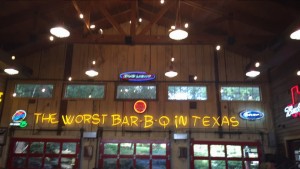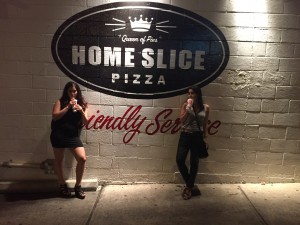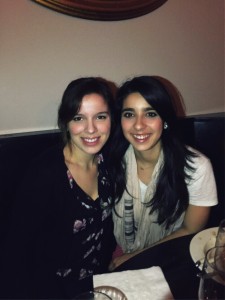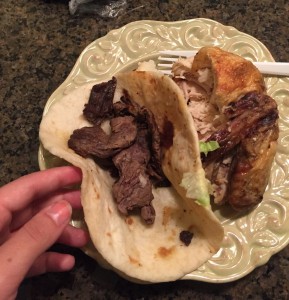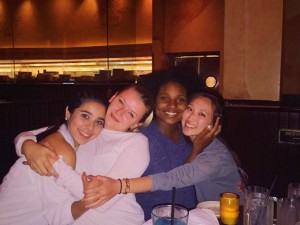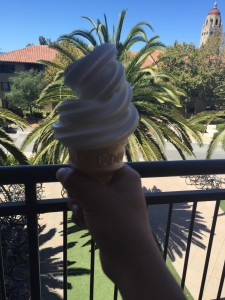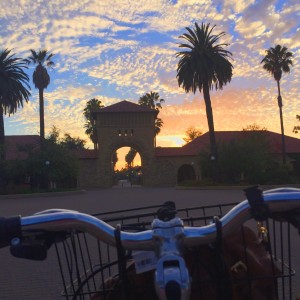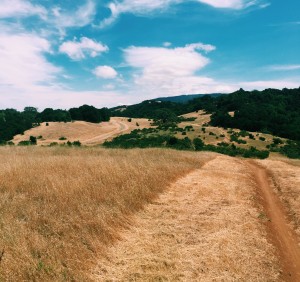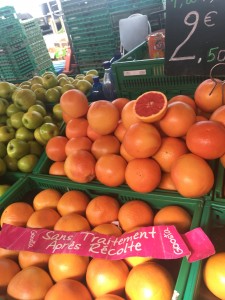These last three months have been a whirlwind of new cities, new people, and new insights. During the first month of summer, I spent time in Austin, Texas; McAllen, Texas (my hometown); Las Vegas; and Liberty, Missouri. I studied for the LSAT, said goodbye to my life in Austin, celebrated my best friend’s birthday, moved out of my childhood home, and gained a family of 56 future public servants (I’m looking at you, TruFam). During the last two months of summer, I conducted research at Stanford University and enjoyed experiencing the California Bay Area. Despite the incredible emotional highs and fast pace of these last five months, I somehow managed to stick to a midnight bedtime, run a couple of miles a week, and drink an unhealthy amount of coffee. Currently, I’m in Angers, France studying abroad during my last semester of college. I am literally eating my way through France and Western Europe.
Austin
In Austin, I spent most of my meals with friends and family. I stayed with my aunt and uncle in the Texas hill country outside of the city and enjoyed home cooked meals and great evening conversations after the local evening news. When I wasn’t breaking bread with family, I was grabbing lunch, dinner, and coffee with friends in an attempt to get in as many goodbyes as possible. Anyone who knows me knows that one of my favorite things to do is to talk with people over coffee at Dominican Jo’s on South Congress or while eating pancakes at Magnolia’s. Austin, once described as a place that has the “same prideful, gabby, strangely infectious psychodynamic,” as the rest of Texas, has a bustling food and drink scene that matches the city’s quirky energy (Draper). Many Austin restaurants pride themselves on using local ingredients, collaborating with small-scale Texas famers to create a two way street of communication. Chefs and restaurants talk and farmers in the city’s 30-mile radius listen and deliver (Lindberg). The food and drinks are spicy and bold (chamoy margarita, anyone?) and are often a blend of trends, cultures and lifestyles. The brick-and-mortar versions of the famous food trucks Chi’lantro and Gourdoughs, two places I frequented both this summer and throughout college, illustrate this point. Chi’lantro BBQ is Korean-Mexican food that prides itself on it’s original kimchi fries—fries that include spicy pork, caramelized kimchi, cheddar + Monterrey jack, cilantro, and sriracha. Gourdough’s Mother Clucker is essentially fried chicken sandwiched between two greasy donuts. And while Austin has no shortage of heavy, flavorful and creative places to grab a quick bite to eat, the city also caters to its health conscious, millennial population.
As someone who lives with a semi-severe allergy to nuts, Austin’s transparent menus and accommodating restaurants are a huge source of relief. You can’t go anywhere in the city without finding a disclaimer about what’s in your food or a waiter who is nothing but understanding about your need to be served with a separate ice cream scooper to avoid cross contamination. Vegetarianism and veganism are also widely accepted and gluten-free options are a staple—no eye-rolling here. However, it’s a double-edged sword. There came a point in my Austin experience when the kale and kombucha began to come off as pretentious, obnoxious, and even a little bit exclusive. East Austin, the new mecca for organic, new wave food spots, has also become the new zone for rapid gentrification. As a result of these shifts in the city’s historic black quarter, the black population has declined to 8% and will continue to fall to 5% in the coming decades (Vincent). The lifestyles these foods represent come at a cost and are beginning to consume the space that has historically been carved out for the city’s black and Hispanic residents. The fact that Austin is the country’s most economically segregated city, a characteristic that positively correlates with ethnic segregation, is also not removed from food (Florida). It’s no secret that Austin loves its breakfast tacos (no really, even The New York Times is in on it). John Edge summarized the Austin breakfast taco as “inspired by Mexico, but not Mexican, a composite food reflecting two cultures” (Edge). Though breakfast tacos can be found in all corners of town, it feels as though the most rabid eaters of this Tex-Mex cuisine are in the places where many Hispanics, the curators of Tex-Mex, patrons are not—South Congress, South First, and South Lamar. Ironically, it appears that eating food, the activity that is supposed to bring us together, is a part of the driving force that is separating us in Austin.
I’m obsessed with food because I believe it should bring us together. Naturally, I spent my last few weeks in Austin eating at the places where I feel comfortable striking up a conversation on just about anything and in places that brought out the parts of Austin I like. My goodbye tour in Austin included frequent visits to The Highball, Polvos, Crow Bar, Taqueria #5, Gueros, Home Slice, Austin Java, and P. Terry’s. I’ve realized that I’m drawn to these establishments because their creative energy and color presentation complement the excitement I get from interacting with others. There’s no denying that I eat like a college student (tacos, cocktails, and fries oh my) and the comfort, convenience, and good vibes of these places don’t make me regret my dietary preferences a bit.
McAllen, Texas
When I speak to people who have taken any sort of health policy class, their eyes light up in recognition when I say I’m from McAllen, Texas. I can usually predict what’s coming. About six years ago, The New Yorker published “The Cost Conundrum: What a Texas town can teach us about health care” and identified my hometown as having one of the most expensive health-care markets in the country (Gawande). In 2006, Medicare spent $15,000 per enrollee even through the per capita income is $12,000. Poverty and rampant obesity are two interconnected factors behind these headlines. Almost 40% of Hidalgo County residents enroll in the food stamp program, meaning that many residents must rely on cheap, processed foods. The consequences are startling: 38.5% of Rio Grande Valley residents are obsess and for the first time anywhere in the United States, South Texas children have a shorter projected life span than their parents (Saslow). Back home, cheap dollar stores, fast food joints, and drive through snack shops offer cheetos with nacho cheese, fruit with chamoy, raspas, and tacos made with beans thickened by lard. The extreme South Texas heat makes it hard for residents to exercise. I didn’t realize what this could mean until I went to college in one of the country’s skinniest citys—Austin, Texas (Owen).
Don’t get me wrong: I love my home. It’s hard to have a conversation with me and not hear me talk about the authenticity of South Texas. I love how our families use food to gather and celebrate each other. I love how our approach to meals is welcoming and underscored by “the more the merrier” mentality. Weekends back home mean barbeque chicken, fajitas, rice, and beans and even though they might also mean answering the question, “tienes un novio?” over and over again, I wouldn’t trade it for anything. If the Austin food scene divides, the McAllen food scene, fueled by the need to gather and strengthen the generational bonds between families, unites and binds.
Palo Alto
During the last two months of summer, I was at Stanford University doing research. I ate the majority of my meals at the Arrillaga Family Dining Commons and occasionally ventured out to Palo Alto to grab some food. If the cities of the California Bay area made up a family, Palo Alto would be the cool, unmarried uncle who wears rimmed glasses, travels the world, bikes, drives a tesla, and always gives you the coolest tech gifts at Christmas. The city is young, rich, and arguably more health conscious than Austin. There isn’t a McDonald’s, but there is a Tava Indian Kitchen (think Indian Chipotle). Outdoor seating is everywhere and the pace of University Avenue, the town’s lively shopping and dining center is leisurely and polished. I picked up some homemade apple pie and ice cream from the Palo Alto Creamery, marveled at all the Asian delicacies, and worked at Blue Bottle Coffee—a shop that caters to techies by allowing patrons to rent out “innovation spaces.”
Arrillaga Dining Commons wasn’t a bad alternative from the casual, picturesque dining of University Avenue. With buffet options for breakfast, lunch, and dinner, you would think that I would gain weight and have eaten some questionable items. I’m happy to report that neither happened. I typically ate oatmeal, fruit, eggs, or a bagel for breakfast with a cup of coffee. For lunch, I ate every meal with a slice of pizza and a soft serve ice cream cone (I am in fact a child). It’s worth mentioning that this was in addition to whatever entrée and sides I had—usually chicken, beans, and some type of rice. For dinner, I would replace the ice cream with fruit and enjoy another balanced meal. Stanford Dining Services divided buffet options into those that enhance immunity, brain performance, food synergy, antioxidants, sports performance, and have anti-inflammatory components (Dining). I would typically have foods from three of more of these divisions and as part of an effort to love my body, I bought an overpriced Nalgene and began drinking about 64 ounces of water a day.
At night, after my GRE class or a long session in the library, I would go to Treehouse or CoHo, the on campus cafes, to drink a beer or glass of wine with friends. Every week I went to bonfires with friends to roast marshmallows and make s’mores—the extent of any late night eating this summer. Unlike Austin, Palo Alto doesn’t have a lively night scene or food spots open past 10 PM to keep you up at night.
My program was generous enough to rent out a bike for me during my time at Stanford. At first, I thought that I could get around without it, but as I realized how massive the campus was (it’s the second largest in the country), I biked everywhere. The cool Bay Area summers and my incredibly flexible schedule also allowed me to spend considerable amounts of time outside reading, talking, and hiking. Riding through campus at night quickly became one of my favorite things to do at night. There’s something about fresh, cool air and getting lost that let’s you relax and enjoy what’s important. I consistently felt alert, well-rested, and fit. After three years of getting too little sleep, not drinking enough water, and not spending enough time outside, my body (especially my skin and my brain) welcomed a short change in lifestyle.
Angers, France
Now that I’m in France, the cultural and social differences surrounding food are becoming more and more evident. I’m currently in T4—one of my favorite cafes in town—getting weird looks from other patrons because I’m alone in a coffee shop working. People do not eat and drink alone here. They spend hours talking and catching up over dinner despite smaller portions that would enable faster dining times. They eat outside and watch the people walking by. And they seem happier and more relaxed than many of the people I saw at my favorite spots back home. As Waverly Root meticulously details in The Food of France, food and wine pairings are intentional and regional (Root). These pairings allow the French to stay connected to their land and history on a scale the United States has yet to do.
These immediate differences have made the think critically about how we use food to communicate truths about ourselves, our culture, and our lifestyles. In the United States, ethnic minorities use food to share culture. In Texas the craze is Mexican food and in California it’s Chinese, Thai, and Korean. In the United States, food is fast and convenient to accommodate our busy work schedules. In certain cities, “grabbing coffee” is professional lingo for networking and no chill. As I explore France and other cities around Europe (Barcelona, Milan, Rome, London, Amsterdam, Brussels, and Munich), I’m keeping my eyes open for how people use food to share and communicate. Feel free to join me on this journey. I’ll be sure to save you a bite.
Bibliography
Dining, Stanford. “Today’s Menu.” 2015 . Stanford Residential and Dining Enterprises. 22 September2015 <https://rdesamapp.stanford.edu/dining/menu.do>.
Draper, Robert. “Beyond Brisket and Burritos in Austin, Texas .” The New York Times 3 December 2013 .
Edge, John T. “Tacos in the Morning? That’s the Routin in Austin.” The New York Times 9 March 2010.
Florida, Richard. “Insight: Segregated City .” 23 February 2015 . Martin Prosperity Institute . 21 September 2015 <http://martinprosperity.org/content/insight-segregated-city/>.
Gawande, Atul. “The Cost Conundrum .” The New Yorker June 1 2009.
Lindberg, Peter John. “It’s Official: Austin is America’s Next Great Food Town .” 11 June 2015.
Owen, Sue. “Surveys find McAllen region most obese among large Texas metro areas.” 7 January 2014. Austin American-Statesman . 22 September 2015 <http://www.politifact.com/texas/statements/2014/jan/07/eddie-lucio jr/surveys-find-mcallen-region-most-obese-among-large/>.
Root, Wavery. The Food of France . New York : Vintage, 1958.
Saslow, Eli. “Too Much of Too Little .” The Washington Post 9 November 2013.
Vincent, Michaelea N. “Resident’s looking to revive Austin’s shrinking black community.” 30 July 2015 . CNN . 21 September 2015 <http://edition.cnn.com/2015/07/30/living/black-austin-population feat/>.
